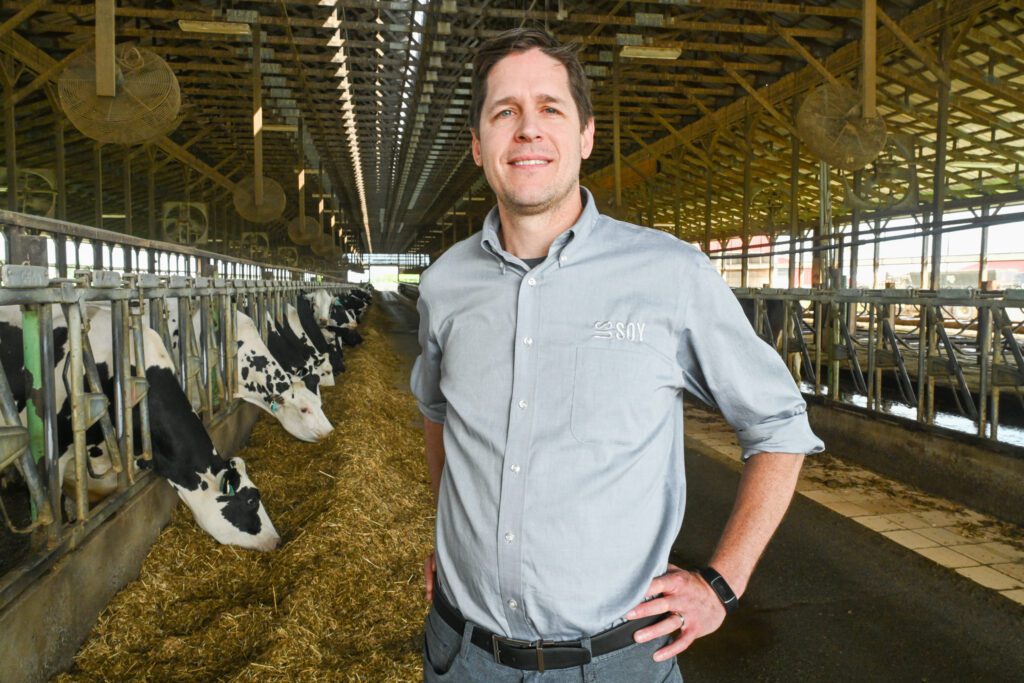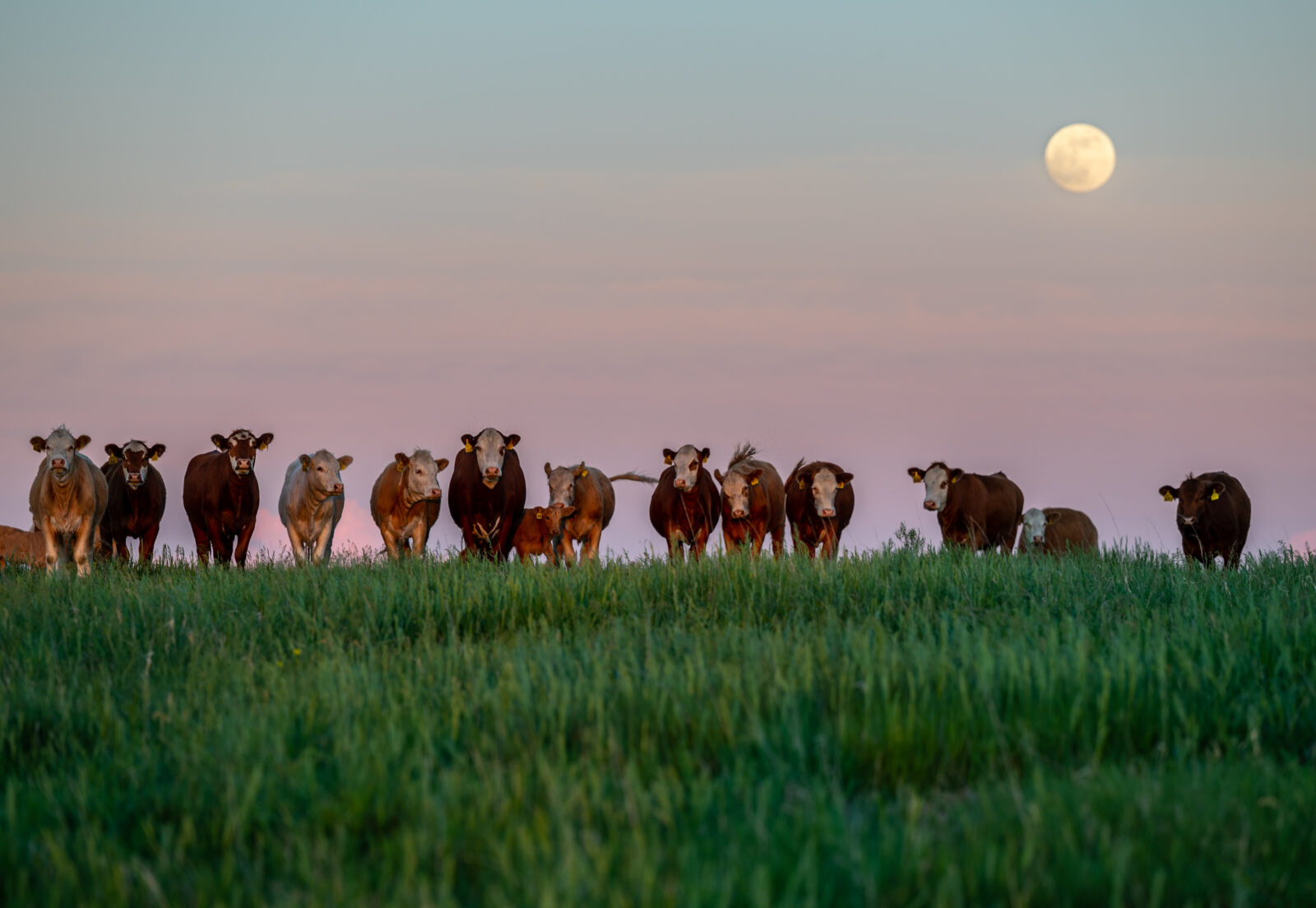Consider steak cuts and blue cheese crumbles on a charcuterie board. Or seasoned ground beef and asadero in a tortilla. A roast beef and sharp cheddar sandwich. Meatballs and parmesan on pasta. Even a cheeseburger.
It’s clear: beef and dairy products go together. Countless options unite these flavorful proteins to create favorite meals.
How do beef and dairy cattle produce those tasty staples that deliver sustainable protein to satisfy any appetite?
The secret is in their stomachs.
As ruminants, cattle have a four-compartment stomach. One of the compartments is called the rumen, which serves as a large fermentation pot. It comes before the other digestive system components. This allows cattle to eat and digest fibrous plants with the aid of microbes, including bacteria and protozoa, that thrive in that stomach.
As a result, the digestion process for cattle echoes the fermentation that produces foods like beer, wine, yogurt, natto, tempeh, pickles, sauerkraut, sourdough bread and more.
“The fermenting bacteria and protozoa in their rumen provide much of the protein and energy cattle need,” says animal nutritionist Bill Miller, Ph.D., president and owner of NeoManna Nutrition. “Soy is added to their diets primarily to deliver amino acids and to ensure a healthy and efficient animal.”
Amino acids are the building blocks of protein, and essential amino acids are those the body can’t manufacture. Soy contains amino acids essential to cattle, helping them build the protein found in so many favorite dishes.
Beefing Up on Soybean Meal
Cattle raised for meat quality need feed that provides adequate amino acids to build protein. That allows beef to serve as an excellent source of protein and supply people with 10 essential nutrients including B-vitamins, zinc and iron,1 whether it’s in a fajita, stew, rouladen, jerky or stir fry.
Soybeans are usually processed to extract their oil. The remaining meal, about 80% of the soybean, becomes a feed ingredient containing protein that delivers essential amino acids to many animals, including beef cattle.
Miller explains that soy protein can be delivered to cattle diets in various forms, such as a heat-treated ingredient, to allow them to best use the amino acids and other nutrients it provides. A research-based approach to feeding cattle evaluates available feed ingredients to determine precisely how much soybean meal and other ingredients should be included to support their health and comfort, taking the concept of a balanced diet even further.
Just a little soybean meal goes a long way for beef cattle. Estimates project that global beef production will increase from nearly 74 million metric tons in 2022 to almost 84 million metric tons in 2032.2 In the U.S., currently beef cattle consume nearly 1.8 million metric tons of soybean meal each year.3 The trends for use of soybean meal from U.S. Soy as a protein source for beef will likely mirror overall production.
“We better understand how each type of soybean meal can also support the microbes growing in the rumen to supply the rest of the nutrients, including amino acids, cattle need to thrive,” Miller adds.
Gut health is critical for cattle, since they rely on bacteria to break down their food. The right mix of ingredients, including soy products, can support that for cattle, much like people look to options like miso or probiotic yogurt to feed beneficial gut bacteria.
Milking U.S. Soy for Sustainable Dairy Feed Value
Cows producing milk to make dairy products like cheese, yogurt, butter or ice cream have high amino acid and energy requirements, according to Miller. One glass of milk delivers 13 essential nutrients, including calcium, protein, vitamins A and D, iodine, selenium and zinc.4
“Again, soy offers a valuable option to provide those amino acids,” he says.
He notes that soybean meal supplements the grass and forage diet for dairy cows where it is readily available. It is typically a small — but valuable — part of their feed. The U.S., currently the second-largest dairy producer globally, uses more than 4.9 million metric tons of soybean meal to augment dairy feed.3 Worldwide, liquid milk production is projected to increase nearly 60 million metric tons by 2032.2 As other producers incorporate efficient feeding practices used in the U.S., use of soybean meal originating in the U.S. for dairy could grow.
“Milk production requires both protein and energy,” Miller says. “With the development of high oleic soybeans, which produce oil containing at least 70% oleic acid,5 more soy can be fed without depressing milk fat. Milk fat has great value for raw milk sales, benefiting dairy farmers.”
High oleic soybeans give dairy farmers the ability to raise or secure an efficient feed ingredient that includes beneficial fat. According to Miller, they can feed high oleic soybeans in various forms, including whole soybeans or higher-fat soybean meal ingredients.
“High oleic soybeans demonstrate the innovation of U.S. Soy,” says Keenan McRoberts, Ph.D., vice president of strategic alignment for the United Soybean Board. “While they deliver solutions for frying food and innovative new uses for soy like biodegradable plastics, they also support dairy system profitability.”

For decades, improvements in dairy production due to technology have been reducing the amount of feed dairy cattle need. From 1944 to 2007, a unit of milk required 23% less feed,6 and then, from 2007 to 2017, feed use intensity decreased another 17%.7 While much of this change can be attributed to improved genetics and animal care, some of it also results from cropping improvements.
“Continuous improvements from U.S. soybean farmers allow them to grow more with less, and they are making progress toward sustainability goals,” McRoberts says. “Innovations like high oleic soybeans and ongoing soy research for the dairy industry represent small contributions to improving dairy production and sustainability.”
He believes U.S. Soy delivers an amino acid profile and a commitment to sustainable and efficient production that effectively supplements cattle nutrition around the world. This combination of qualities in a plant-based protein source ensures that both beef and dairy products continue to deliver flavorful, sustainable nutrition.
1 Beef’s Nutrition Benefits, Cattleman’s Beef Board, accessed June 2023.
2 WAEES, “Global Agricultural and Biofuels Forecast Summary: A Proprietary Forecast for the United Soybean Board-May 2023,” 2023, Columbia, MO.
3 U.S. Soybean Meal Feed Use by Species, Market View Database, June 9, 2023.
4 Milk Facts and Health Benefits, U.S. Dairy and National Dairy Council, accessed June 2023.
5 High Oleic Soybeans, Missouri Soybean Merchandising Council, May 2019.
6 The environmental impact of dairy production: 1944 compared with 2007, J.L. Capper, R.A. Cady and D.E. Bauman, Journal of Animal Sciences, June 2009. doi: 10.2527/jas.2009-1781
7 The effects of improved performance in the U.S. dairy cattle industry on environmental impacts between 2007 and 2017, J.L. Capper and R.A. Cady, Journal of Animal Sciences, January 2020. https://doi.org/10.1093/jas/skz291
